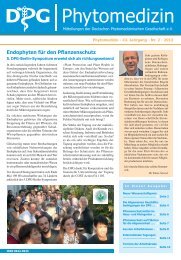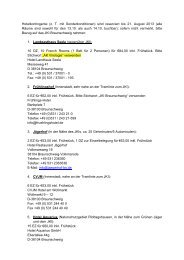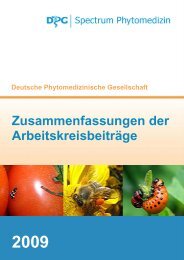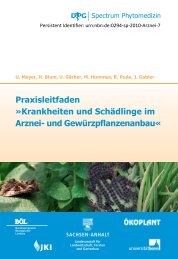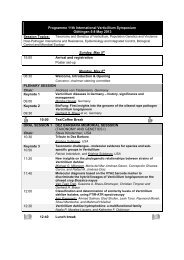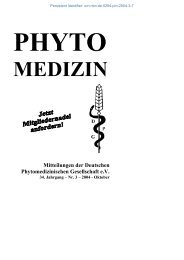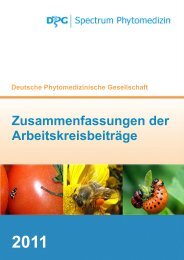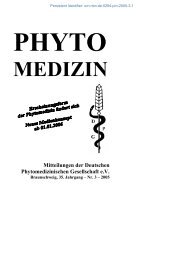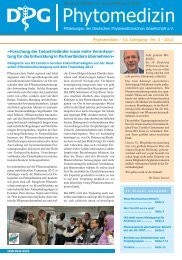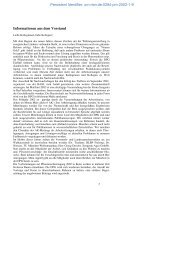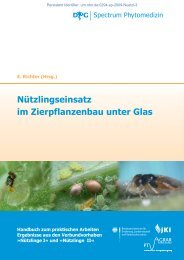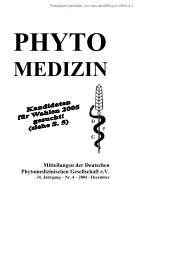fourth joint meeting of dutch and german
fourth joint meeting of dutch and german
fourth joint meeting of dutch and german
You also want an ePaper? Increase the reach of your titles
YUMPU automatically turns print PDFs into web optimized ePapers that Google loves.
Characterization <strong>and</strong> nucleotide sequence <strong>of</strong> Grapevine leafroll associated virus-7 (GLRaV-<br />
7)<br />
C Mikona <strong>and</strong> W Jelkmann<br />
Biologische Bundesanstalt für L<strong>and</strong>- und Forstwirtschaft, Institut für Pflanzenschutz im Obstbau,<br />
Dossenheim<br />
E-mail: c.mikona@bba.de<br />
Leafroll is a widespread disease <strong>of</strong> grapevine causing yield losses <strong>of</strong> economical importance.<br />
Filamentous <strong>and</strong> phloem-restricted viruses <strong>of</strong> the family Closteroviridae are associated with the<br />
disease. Up to now 9 serological distinct viruses are described. They are referred to as Grapevine<br />
leafroll associated virus -1 to -9 (GLRaV-1 to -9) which appear as single or mixed infections in<br />
grapevine. The available partial or complete determined nucleotide sequences confirm the<br />
serological characterization so far.<br />
GLRaV-7 was isolated as double str<strong>and</strong>ed RNA (dsRNA) from dormant wood <strong>of</strong> a grapevine <strong>of</strong><br />
Albanian origin. This isolate referred to as “AA42” displayed a b<strong>and</strong> pattern in gel electrophoresis<br />
as known for GLRaV-1 <strong>and</strong> -3. The first GLRaV-7 specific cDNA clones have been obtained by<br />
DOP-PCR. Subsequent cloning was carried out by RT-PCR. Different approaches have been<br />
attempted for the determination <strong>of</strong> the 5’- <strong>and</strong> 3’- terminal sequences. RACE-PCR with poly(A)tailing<br />
<strong>of</strong> dsRNA <strong>and</strong> subsequent RT <strong>and</strong> PCR with Oligod(T)+anchor <strong>and</strong> anchor primer,<br />
respectively, or RACE-PCR with RT first, subsequent poly(A)-tailing <strong>and</strong> two polymerase chain<br />
reactions with Oligod(T)+anchor <strong>and</strong> anchor primer, respectively, were carried out. Another attempt<br />
with circularization <strong>of</strong> the viral genome to enable RT <strong>and</strong> PCR over the 3’/5’-end was ab<strong>and</strong>oned<br />
due to no positive results <strong>of</strong> the control PCR (check if the circularization took place). 14.363 base<br />
pairs <strong>of</strong> the “AA42” nucleotide sequence have been determined so far. Genomic analysis revealed<br />
a genome organization as typical for closteroviruses. The putative translation products <strong>of</strong> the<br />
determined ORF sequences were compared to other proteins in the database <strong>and</strong> showed<br />
similarity with translation products <strong>of</strong> Little cherry-virus -1 (LChV-1).<br />
Multiple sequence alignment with “Neighbor-Joining-Tree”-generation based on the amino acid<br />
sequence <strong>of</strong> the HSP70 protein confirmed the close relationship between LChV-1 <strong>and</strong> GLRaV-7,<br />
both unassigned members <strong>of</strong> the family Closteroviridae.<br />
For accurate characterization <strong>of</strong> the GLRaV-7 genome terminal sequences have to be completed.<br />
The spread <strong>of</strong> Rice yellow mottle virus in irrigated rice crops<br />
S Sarra 1,2 <strong>and</strong> D Peters 2<br />
1 Institut d’Economie Rurale, Projet Riz Irrigué, Niono, Mali<br />
2 Laboratory <strong>of</strong> Virology, Wageningen University<br />
E-mail: dick.peters@wur.nl<br />
Rice yellow mottle virus (RYMV), a sobemovirus, is endemic in Africa, south <strong>of</strong> the Sahara, <strong>and</strong><br />
occurs mainly in irrigated rice ecosystems. Infected plants give yellow or orange discoloured rice<br />
leaves, a delay in plant growth <strong>and</strong> reduced tillering. These symptoms result in lower yields, but<br />
early infected plants give the highest losses as they fail to set fruit. RYMV is primarily known as a<br />
beetle-transmitted virus. A scattered distribution <strong>of</strong> infected plants <strong>and</strong> the occurrence <strong>of</strong> small<br />
infected spots might be the result <strong>of</strong> RYMV spread by beetles. However, various infection patterns<br />
can with difficulty be explained by beetle transmission. Small infected spots occur next to field-wide<br />
spots (20 m or more in diameter). Completely infected crops are found next to completely healthy<br />
crops. Infected plants can be found on untided-l<strong>and</strong> along roadsides, levees <strong>and</strong> at corners. Severe<br />
infections can occur in parcels in which cows have been housed for the night in the contra-season.<br />
These observations stimulated us to search for other mechanism by which RYMV could spread in<br />
the field. Transplantation <strong>of</strong> seedbeds with a limited infection resulted in a drastic increase <strong>of</strong><br />
infected plants in the field. This number increased again sharply 3 to 4 weeks after transplantation<br />
due to wind-mediated leaf contact <strong>and</strong> root-released virus from infected plants as shown in field<br />
<strong>and</strong> greenhouse experiments. Weeding, application <strong>of</strong> fertilizers may also enhance the number <strong>of</strong><br />
infected plants. Some infections are caused by cows <strong>and</strong> donkeys occasionally fouraging on rice,<br />
<strong>and</strong> by grass rats gnawing plant on tided l<strong>and</strong>. Mowing an infected crop, <strong>and</strong> fouraging stubble<br />
fields enhance the inoculum which can infect the next seedbed by virus released from infected<br />
plants when plowed down <strong>and</strong> other mechanisms such as beetles <strong>and</strong> rats. Some severe seeded<br />
infections can occur when frequented by cows. The spread <strong>and</strong> epidemiology <strong>of</strong> RYMV as deduced<br />
from our results will diagrammatically be presented.<br />
28



